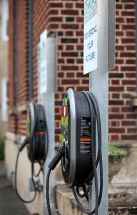Good things come in trees Reflections on our complicated relationship with Christmas conifers
Read this article for free:
or
Already have an account? Log in here »
To continue reading, please subscribe:
Monthly Digital Subscription
$0 for the first 4 weeks*
- Enjoy unlimited reading on winnipegfreepress.com
- Read the E-Edition, our digital replica newspaper
- Access News Break, our award-winning app
- Play interactive puzzles
*No charge for 4 weeks then price increases to the regular rate of $19.00 plus GST every four weeks. Offer available to new and qualified returning subscribers only. Cancel any time.
Monthly Digital Subscription
$4.75/week*
- Enjoy unlimited reading on winnipegfreepress.com
- Read the E-Edition, our digital replica newspaper
- Access News Break, our award-winning app
- Play interactive puzzles
*Billed as $19 plus GST every four weeks. Cancel any time.
To continue reading, please subscribe:
Add Free Press access to your Brandon Sun subscription for only an additional
$1 for the first 4 weeks*
*Your next subscription payment will increase by $1.00 and you will be charged $16.99 plus GST for four weeks. After four weeks, your payment will increase to $23.99 plus GST every four weeks.
Read unlimited articles for free today:
or
Already have an account? Log in here »
Hey there, time traveller!
This article was published 09/01/2020 (2164 days ago), so information in it may no longer be current.
When I arrive at the Rainbow Stage parking lot at Kildonan Park on Jan. 2, there are probably 30 Christmas trees beneath a sign that reads NO DUMPING, threatening a $300 fine.
But this isn’t illegal dumping. From Dec. 27 to Jan. 31, this parking lot is one of 10 City of Winnipeg Christmas tree recycling depots for the Let’s Chip In program.
Over the course of the month, more than 10,000 trees will be dropped off at these depots.
I’m waiting to talk to Mark Kinsley, the city’s supervisor of waste diversion, but I’m early. While I wait, I decide to indulge my curiosity about the trees, which are still green and fragrant.
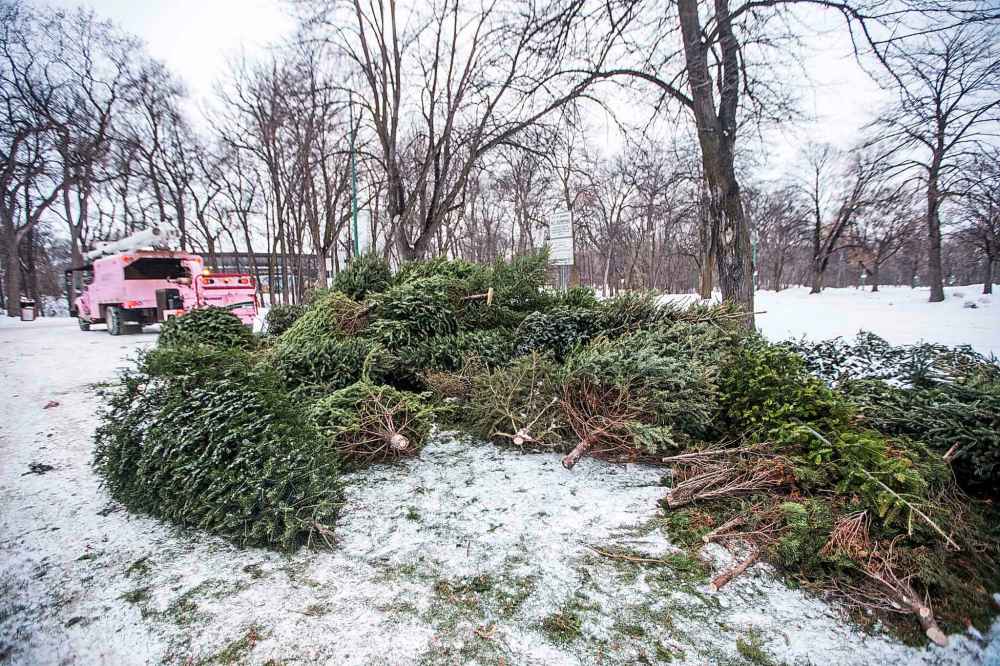
I walk around the pile. Most of the trees are bare, following the city’s edict to “remove all decorations, tinsel, stands and plastic tree bags” but it doesn’t take long to find one tree covered with straw ornaments and another with a couple of plastic/glitter-covered decorations.
Looking around, I realize that about 10 or 12 trees still have long thin plastic tags attached to their lower branches.
The majority of the tags are blue but a few are white and one is red. In a strange way, they look like extra ribbons from the presents piled underneath them.
I tug off both the simple stars and the complex plastic.
There are two tags from quebecbalsams.com, a Premium Balsam, 6-7 feet and a Premium Balsam, 7-8 feet. There are two from the more mysteriously named LBJ, a Fraser Fir, 8-9 feet and a Fraser Fir, 6-8 feet. There’s a Balsam Fir Kriss Kringle Premium 7’-8’ tree from Somerville Nurseries in Ontario.
It’s hard to know where these trees were purchased, whether it was a pop-up vacant-lot Christmas tree operation or a big-box store such as Walmart or Home Depot.
Some of these trees are licensed by the stores themselves, produced under a store label. One of the tags is from Superstore, listing it as a “PC Christmas Tree” while the label for the tree from IKEA just says “Abies / Made in Canada.”
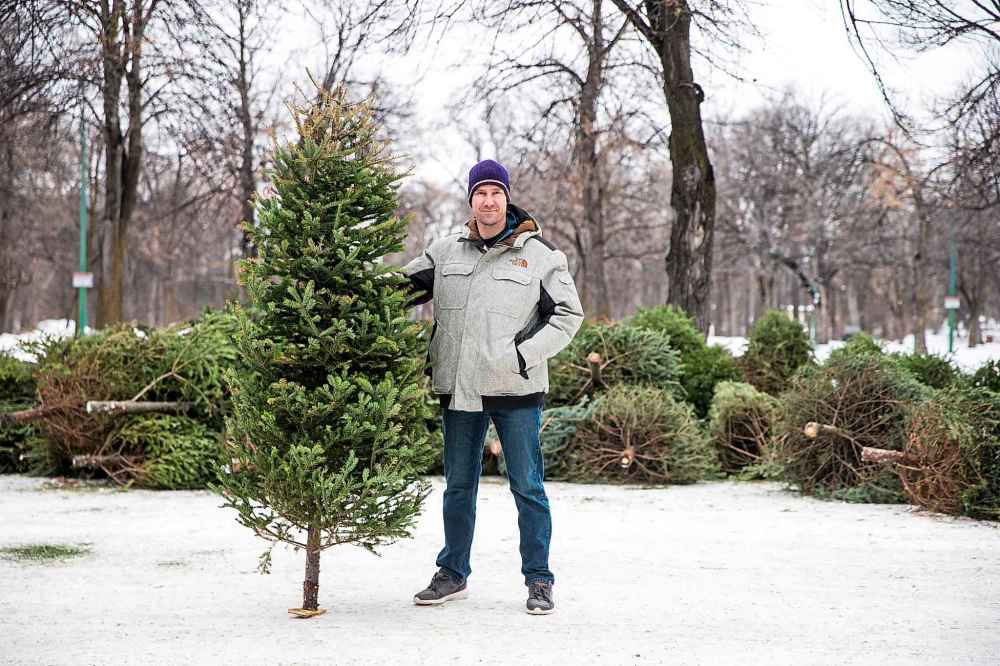
For a couple of weeks, each were someone’s favourite tree. People decorated them, piled presents under them, and spent time looking at them and breathing in great deep breaths of pine-scented air.
But for me, these tags mark the point where trees become commodities, sold in bulk and shipped in from all points.
I have already leaned back one or two times into the soft/spiky green mound of trees, treating them like a mattress, treating them like a grove of trees, when a big pink truck hauling a pink woodchipper pulls into the parking lot.
● ● ●
We have a cat we affectionately call “Phillip-the-Asshole.” After a somewhat exhilarating physical exam at his November appointment, the vet said Philly needed to lose some weight.
So, over the past months, Phillip — nasty and smart and in search of food — has jumped up onto surfaces we didn’t think he could reach and eaten into bagged loaves of bread.

We figured that he’d climb and destroy a Christmas tree, so we didn’t do one this year. But I knew my friends and neighbours still had trees, from seeing lit-up trees in the front windows as I walked around my neighbourhood and from photos being posted to social media.
So I asked my friends on Facebook: “So did you get a real Christmas tree this year? Why/why not?”
“Always real,” replied Laura Rawluk, an avid gardener who lives in West Broadway. “Love the scent. We keep them in the garden for the birds and burn them in the firepit in the summer. We also add the ash to the compost.”
I like that Laura has figured out how to use her Christmas tree throughout the year. But that’s Laura: thoughtful, thorough, and ecologically minded.
Lynne Martin, a playwright and freelance writing tutor/editor who lives downtown, came down on the other side of the debate.
“I still have the artificial tree Omar and I bought from a thrift store back in the 1980s,” commented Lynne. “The idea of watching a live tree die slowly in my living room makes me more sad than I can say.”
When Lynne sends me a picture of her tree, which is now at least in its third decade of use, she elaborates on the web of relationships around the tree.
“Omar was my first husband and the wonderful father of my children. He died in 2002. Most of the ornaments you see were collected during our 24 years of marriage, though a few, like the angel on top, have come during my marriage with Armin.”
Another friend, Mary East, has a fake tree but also three dogs. On Dec. 19, less than a week after putting up her tree, Mary posted “I have taken down the Christmas tree because of Chai’s commitment to electrocuting herself.”
Luckily, Mary was able to continue on with her other Christmas tree tradition this year, which is putting sunflowers in her backyard pine tree. She loves the way it looks and the birds seem to love it, too.
“It is the only reason I grow sunflowers,” says Mary.
● ● ●

It takes workers less than a half hour to reduce the pile of Christmas trees to wood chips. And that includes time to shake snow and other debris off the trees, to examine them for metal and plastic before heaving them into the chipper, and even to sweep up the fallen needles.
But that’s not surprising: this is the 28th year of the program. They’ve got the routine down.
In that time, the program has diverted 391,438 trees from the landfill, producing 1,781 tonnes of mulch.
In the first years of the program, as many as 21,430 trees were recycled and around 2012 it was still as high as 14,000 to 15,000. But recently, the number of trees being recycled sits between 10,000 and 11,500 trees, which is between 45 and 50 tonnes of wood chips.
Kinsley said he would like to see those numbers increase again, though he says that the missing 3,000 trees probably aren’t going to landfill. They’re being installed in backyards as habitat for birds and rodents or providing windbreaks for skating rinks on our rivers.
The city lets people take away as much of the mulch as they want, which is meant for use around shrubs or the base of big trees instead of in vegetable gardens or flower beds because of the acidity of the needles.
They use the remainder for paths in City of Winnipeg parks and this year they anticipate that the soil manufacturing program, currently a pilot program that diverts woody debris, street sweepings, and biosolids (read: human poop), will consume most of the mulch.
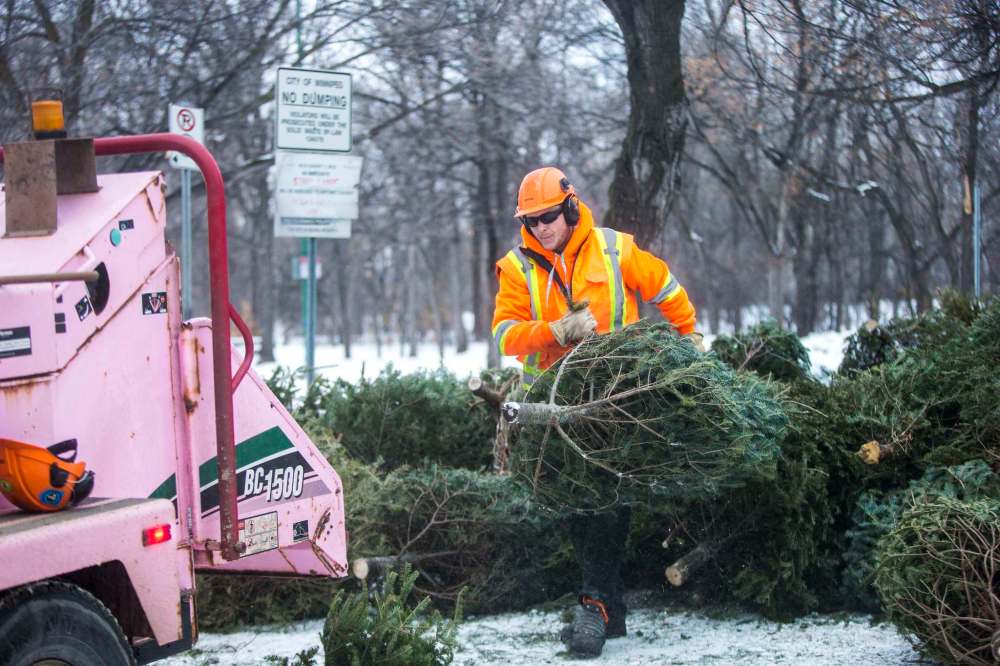
● ● ●
The evergreen debate when it comes to Christmas trees is which is more environmentally sound, real or fake trees?
Fake trees are easy to define. Needles made of polyvinyl chloride (or PVC) or polyethylene (or PE) are arranged on a steel frame. If the branches are ‘snow-tipped’, a layer of white latex paint is added.
Carex Canada says PVC is used in the manufacture of automotive parts, pipes, medical supplies, packaging products, furniture, and construction materials.
Vinyl chloride is a colourless gas used to create PVC and is a known human carcinogen, though the highest exposures are during manufacturing.
PVC can also include chemical additives such as phthalates, lead, cadmium, and organotins. PE is supposed to be a bit cleaner/safer, but PE Christmas trees are still not recyclable.
Research shows that you have to keep artificial trees for 20 years or more for them to rival a real tree, given the manufacturing process and the carbon footprint of shipping them from factories, usually in China, to retail locations. There are also questions about the plastic breaking down after a decade’s use.

On the plus side, over 20 years, one fake Christmas tree equals 20 ten-year-old trees. That’s a small grove of trees. They’re also good options for people allergic to real trees and are the only options in most condos and apartment blocks, who ban real Christmas trees because of the potential fire hazards (even though fake Christmas trees can present similar danger).
Real trees can come from plantations or woodlots or even Crown land, if you apply for a permit. They can be species native to Manitoba or non-natives shipped in from Ontario or Quebec, which makes for a similar carbon footprint to the artificial trees.
And, like any plant grown and harvested for human consumption, they can be treated with pesticides and herbicides. Sometimes, they’re even spray-painted green to hide brown sections of trees.
Now, most people cite the smell as the chief reason they get a real tree instead of a fake one.
What they’re smelling are phytonicides, otherwise known as anti-microbial volatile organic compounds or wood essential oils and are part of trees’ defence systems, helping to protect them against the incursions of bacteria, insects, and fungi. In his book Forest Bathing: How Trees Can Help you Find Health and Happiness, Dr. Qing Li explains, “phytonicides are also part of the communication pathway between trees, the way trees talk to each other.”
In his research, Li showed that human exposure to phytonicides led to significantly decreased stress hormones, increased the number of hours of sleep, and increased the activity of anti-cancer proteins in the body.
Forest bathing, which was developed in Japan, combines exposure to phytonicides with the benefits that can be accrued from moderate exercise and contact with nature.
Evergreens are the largest producers of phytonicides, so having a real Christmas tree can have health benefits.
In addition, real trees sequester carbon from the atmosphere and produce oxygen during their lifetime. According to the Manitoba Christmas Tree Growers Association, one hectare of Christmas trees provides the daily oxygen requirements for 45 people.
But there’s a third option. Not having a Christmas tree or even just decorating with pruned conifer boughs or wreaths. Some people decorate houseplant-sized Norfolk Island pines or small cypresses year after year.
● ● ●
It’s Jan. 4, the first Saturday after New Year’s, and I’m standing in front of École Laura Secord School with Captain James Arkle of the 38th Service Battalion.
Every few minutes, a khaki-coloured pickup truck, stuffed to the brim with discarded Christmas trees, arrives and is quickly unloaded by uniformed reservists.
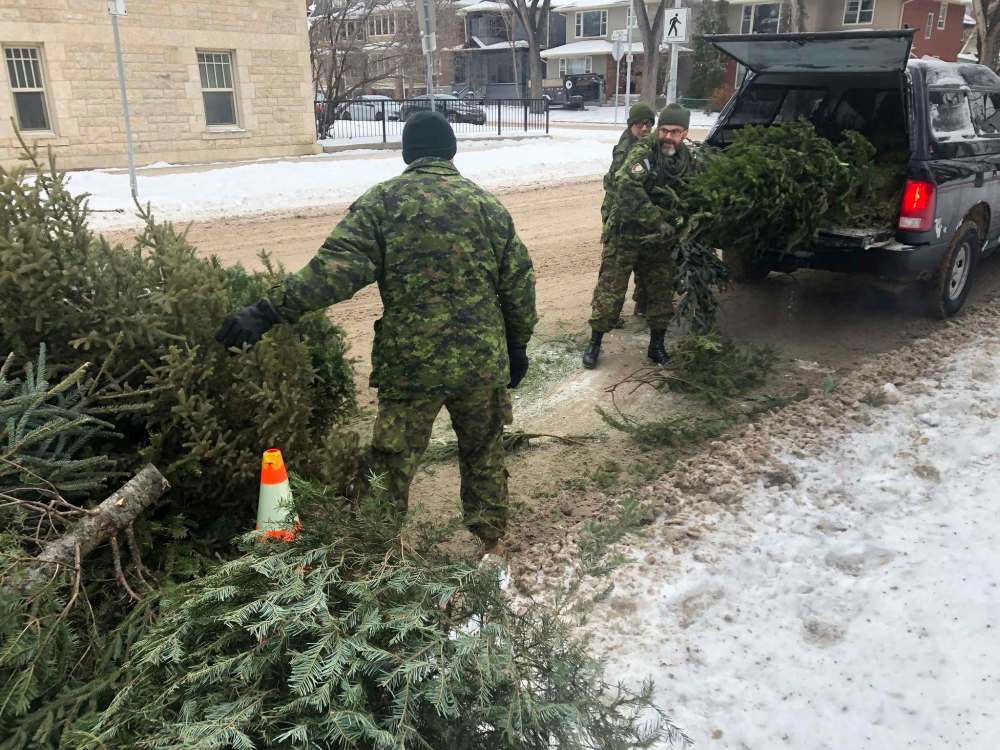
The battalion has been picking up trees in Minto and Wolseley for free since 2009.
“We do this in order to get out and interact with the public and show them what we do as a Service Battalion,” Arkle said. “We also use this as an opportunity to practise our driving skills and allow our junior officers an opportunity to lead a small scale exercise.”
One thing the battalion has learned in that decade is that they can’t drive their big army trucks down Wolseley’s tree-lined streets without damaging overhanging branches. So they use these smaller trucks to collect trees from the residential streets, which keeps the big trucks on collector streets.
As Arkle is talking, a tree is thrown from the back of a pickup onto the quickly-growing pile of trees, which will delivered at the end of the day to the tree recycling depot at the St. James Civic Centre.
“We focus here because it is the area we operate out of and we understand that it can sometimes be an inconvenience for people,” Arkle said. “It’s our way of saying ‘thank you’ for understanding.”
Another truck, another series of trees hauled out of the back and heaved onto the pile. The trees and the reservists, dressed in the temperate woodland camouflage, are a blur of green and brown.
The battalion will pick up about 500 trees in Wolseley and Minto today, but if you don’t live in either neighbourhood, there are other options for diverting real trees from the landfill.
You can hire Sscope Inc., a non-profit that provides environmentally conscious social enterprise-focused employment for people living with mental health illnesses. For a small fee, Sscope will transport your tree to one of the depots.
The Festival du Voyageur is also looking for Christmas trees to decorate Voyageur Park and is asking that they be dropped off at the Fort Gibraltar parking lot, and Aurora Farm in St. Norbert has put out a call for trees, which they use as fodder for their herd of dairy goats.
* * *
I had hundreds of comments on my Xmas tree thread, so I decided to push my luck and ask a follow-up question:
“For those of you that had real trees this year, did you spend time with them? Do you consider yourself to be in relationship with them? (Like you might the tree in your yard?)”
Katherine Bitney, a poet who lives in the North End and practices Wicca, responded right away.
“Yes, I speak to the tree and thank it for the sacrifice, and for its beauty and wonderful scent. I speak to it everyday when I water it,” said Katherine.
“The tree has kindly given me the gift of its body and life so I can celebrate the Solstice. Giving thanks and praise is the least I can do.”
And then Toronto writer Rebecca Rosenblum chimed in.
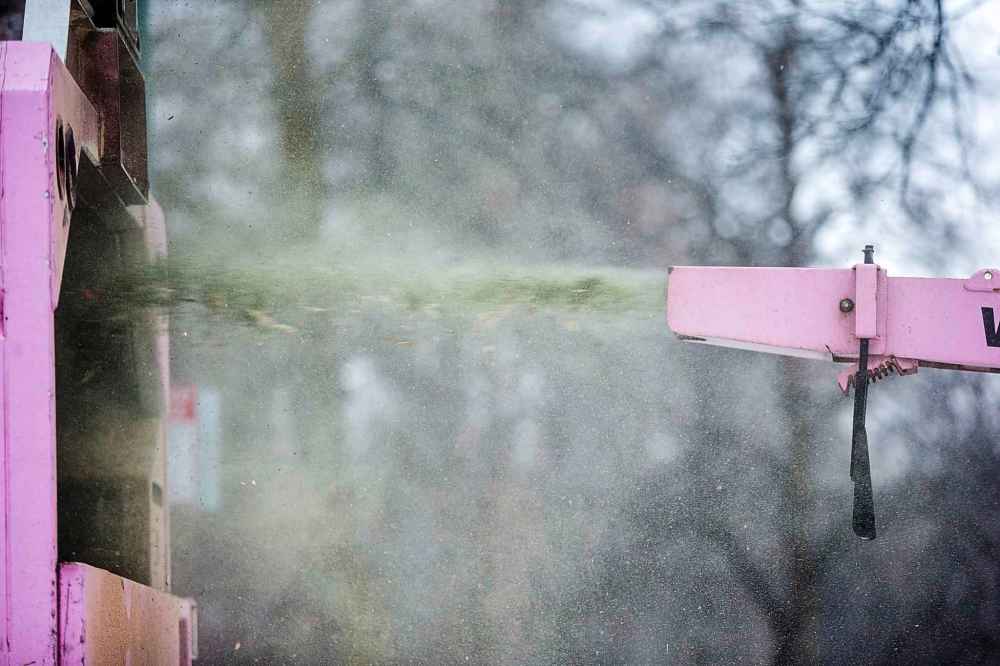
“We don’t have a tonne of space, so adding anything tree-sized creates a relationship that is of necessity intimate,” said Rebecca. “We had ours for about three weeks (it departed this morning) and I would say I knew it as well as I knew outdoor trees I’d lived with for years — exactly where a branch crooked or there was a bare spot — because it was between our dining table and our couch, and I just looked at it all the time. Thanks for making me think about this — I didn’t, really, before, but it was nice!”
* * *
The last thing I did before leaving the Rainbow Stage parking lot was to climb up on the back of the truck holding all the chipped Christmas tree.
I stuck my face in and took deep breaths.
The pine scent washed over me as I ran through all the arguments and counter-arguments for and against Christmas trees one last time.
In the end, I settled on gratitude that the trees get a second life, that they’re not just disposable. I settled on gratitude to a truckful of everyone else’s favourite trees.
Do you have a favourite tree? Tell me about it at favouritetrees@gmail.com.
Ariel Gordon is a Winnipeg writer.

Our newsroom depends on a growing audience of readers to power our journalism. If you are not a paid reader, please consider becoming a subscriber.
Our newsroom depends on its audience of readers to power our journalism. Thank you for your support.












